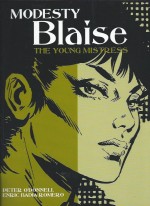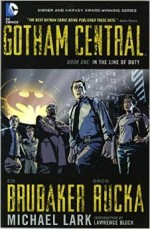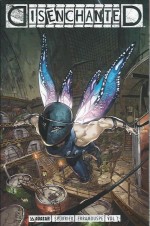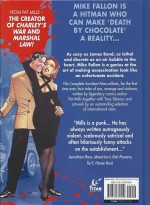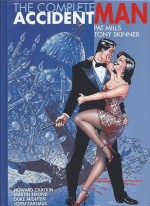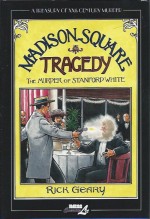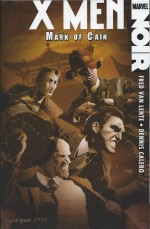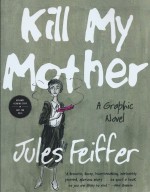
By Jules Feiffer (Liveright/W.W. Norton)
ISBN: 978-0-87140-314-8
Win’s Christmas Gift Recommendation: Smart, Sharp and Perfectly Put Together… 9/10
Jules Ralph Feiffer has always been much more than “just a comic-book guy†even though his credits in the field are sound and suitably impressive. As well as working with Will Eisner on The Spirit, he created his own Sunday strip ‘Clifford’ (1949-51) before settling at the Village Voice for a Pulitzer Prize winning run.
Novelist, playwright, animator, children’s book creator (why isn’t there a single word or term for those guys?), teacher and screenwriter, he turned his back on cartooning in 2000, but the 42-year run of his satirical comic strip in The Village Voice ranks as some of the most telling, trenchant, plaintive and perspicacious narrative art in the history of the medium.
The strip, originally entitled Sick, Sick, Sick, then Feiffer’s Fables, before simply becoming Feiffer was quickly picked up by the Hall Syndicate and garnered a devoted world wide following, with many collections appearing over the years since the first book in 1958.
His incisive examination of American society and culture, as expressed through politics, art, television, cinema, work, philosophy, advertising and most especially in the way men and women interact, informed and shaped opinions and challenged accepted thought for generations. They were bloody funny and wistfully sad too – and still are today.
However his creative credits extend far beyond the world of print: he was one of the playwrights on stage revue Oh! Calcutta! (with Kenneth Tynan, Edna O’Brien, Sam Shepard, Leonard Melfi, Samuel Beckett & John Lennon) and has created 35 plays, books and screenplays including Carnal Knowledge and Little Murders. In 1961 his animated short feature Munro won an Oscar.
In 1965 he kickstarted acedemic American comic fandom with his celebratory evaluation The Great Comic Book Heroes and in 1979 he was at the forefront of the creation of graphic novels with Tantrum before scripting Robert Altman’s much-undervalued Popeye movie (released a year later).
He has a Lifetime Achievement Award from the Writers Guild of America, was elected to the American Academy of Arts and Letters in 1995, and 2004 saw him inducted into the Comic Book Hall of Fame and simultaneously receive the National Cartoonists Society’s Milton Caniff Lifetime Achievement Award, and 2006 saw him awarded the Creativity Foundation’s Laureate.
Now after years as a cartoonist, illustrator, pundit and educator, at the age of 85 (having been born in the Bronx on 26th January 1929) he has returned to his primary role of storyteller with another gripping and innovative graphic novel.
…And what a yarn he’s spun…
Spanning ten turbulent years, Kill My Mother is a supremely classy tribute to Film Noir, Hollywood Babylon, sexual politics and family secrets, blending the trappings of Dashiell Hammett with the tone, pacing and spark of Preston Sturges and Billy Wilder to tell an extended story of love, murder, jealousy and revenge.
It all begins in ‘Bay City Blues’. It’s 1933 and times are tough. Fifteen year old Annie Hannigan is cutting up, constantly leading poor, gullible sap Artie Folsom into trouble, whilst the mother she despises works all hours for dissolute, dipsomaniac and exceedingly cheap private investigator Neil Hammond.
The odd arrangement developed after the shamus agreed to investigate the murder of Elsie Hannigan‘s husband, whom he constantly refers to as the wrong sort of honest cop.
Events take a dark turn when stylish, exceedingly tall man-eater Mae Longo walks in offering outrageous sums if the shamus can track down a certain woman. The photo she gives him shows a woman remarkably like his coolly aloof new client…
Eddie “the Dancing Master†Longo is a rising star of the fight game who usually employs shady and capable gorilla Tiny Tim Gaffney to handle the more unsavoury problems in his life but Neil claims he knows how to handle him…
In the course of her mean-spirited, casual rebellions Annie gets poor Artie into real trouble when a shoplifting binge results in a pursuit by a store detective far faster than he looks. A very nasty beating is only avoided when an exceptionally tall derelict in an alley lays out the private cop with her carefully concealed baseball bat…
The rattled teen takes the tramp back to the apartment and cleans her up even as Elsie, very much against her will and better judgement, is dragged by soused-as-ever Neil to the Big Fight to see the Dancing Master.
The escapade almost costs her everything…
Her drunken boss’ plan to draw his tall target out of the woodwork also involves poor Elsie and leads to a lot of pain, trouble and strife, whilst Hammond, clearly a dipsomaniac with a death wish, starts dogging mysterious client Mae instead of doing the job he was hired for.
The result is a murder unsolved and unexplained for a decade…
The concluding half of the story resumes in 1943 with ‘Hooray for Hollywood’ as we return to our cast and find them all greatly advanced.
Goonish Artie is a Captain of Marines, successfully battling the Japanese in the Green Hell of the Pacific whilst Annie Hannigan is a writer and media darling. Her sensational hit comedy “Shut Up, Artie†is the most popular radio show in America and broadcast wherever Yanks are posted.
Eddie Longo has made the transition to B-Movie star and Ellen – when not babysitting her obstreperous grandson Sammy – is “Executive Vice President of Pinnacle Studios in charge of Image Security and Maintenanceâ€â€¦
The scary indigent little Annie met in an alley has also cleaned up and moved on. Now she sings torch songs in the Reno Roost as the enigmatic Lady Veil…
Eddy hates his life. The former hard-man boxer is trapped as a song-and-dance hoofer in big, morale-boosting musicals but dreams of major stardom like glamorous He-Man Hugh Patton or even an Academy Award, but is typecast and more under the thumb of the formidable Mae than ever.
The fraught status quo changes after Annie meets the dashing Patton at the Hollywood Canteen, but her romantic elation is crushed soon after when the sponsors call her in to discuss a crisis.
A genuine war hero is suing the show, claiming his life is being made a mockery. Unless she can fix things up with her old pal Artie, the show and her career are over…
Eddie is also near breaking point and Mae is forced to call in the thuggish Gaffney as a minder.
Events begin to spiral to a shocking conclusion when Longo joins a USO tour to the war-torn Pacific Islands. Patton is going too and Annie takes the opportunity to join him, as does her mother in the role of “image maintainer 
The first port of call is Tarawa; the hellhole where Captain Arthur Folsom is almost single-handedly repulsing the Jap advance…
On the island Artie is overseeing the building of the stage for the visiting stars and marvelling at the stupidity of putting on a show in battleground still hotly contested by enemy forces. In the air above him Ellen has a sharp confrontation with Mae Longo and “bodyguard†Gaffney. The events of ten years ago are still painfully fresh in every participant’s mind.
By the time all the players debark on the island, a devious and supposedly foolproof plan to commit another perfect murder has been hatched, using the Japanese as ideal scapegoats, but intimate killing is far harder than mass slaughter and the scheme soon begins to unravel…
Complex, beguiling, smartly sophisticated, devastatingly witty and peppered with casual shocking violence as every noir thriller has to be, this is a spectacular yarn – available in both hardback and mass market paperback editions – packed with twists and surprises, where nobody is telling the truth and no-one is playing on the side of the angels.
A masterpiece of cool suspense, mature ingenuity and graphic dexterity, Kill My Mother offers a timeless, hearty slice of bravura storytelling that gets better with every re-reading.
If you love crime yarns, comic tales, nostalgia and having your intelligence respected, this is the book for you.
© 2014 Liveright Publishing Corporation.

